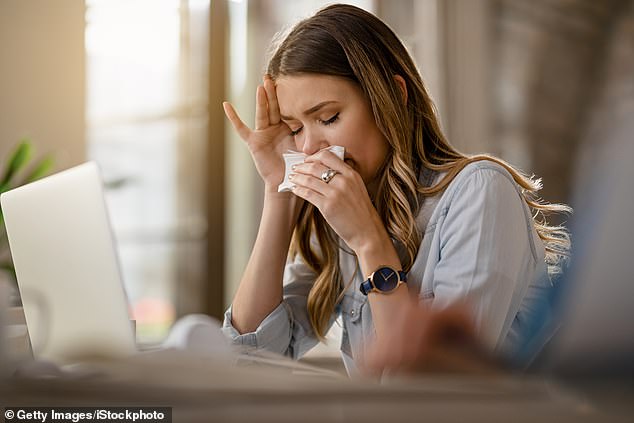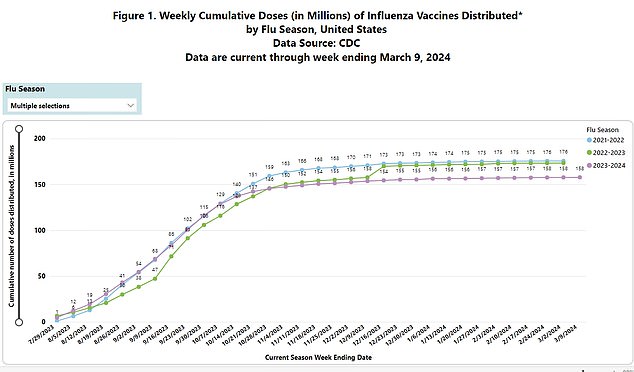Is Everyone You Know Sick Right Now? Here’s Why
The summer heat has only just abated, but people across the country are still falling ill with symptoms normally seen only in winter.
If you notice that many of your colleagues are sick or sitting in the office with a cough, runny nose and fatigue, you are not alone.
The US is reporting persistently high levels of Covid-19 again, after a summer that already saw record numbers of infections, with everyone from President Biden to New York Mayor Eric Adams stricken with the disease.
And the combination of poor immunity from lockdowns and social distancing and low vaccination rates means old viruses are causing more severe illnesses that last longer than the normal cold and flu season.
NYC Mayor Eric Adams tested positive for the Covid virus in September 2024. According to CDC data, he is one of the 16 percent of people who have tested positive for the disease.

President Biden tested positive for Covid shortly after his debate with former President Trump, at the start of the summer coronavirus surge
Dr Eve Elizabeth Pennie, a GP and DrugWatch contributor, told DailyMail.com: ‘It certainly seems like more people are getting sick recently and there’s a good reason for that.’
Dr Pennie explained that the lockdowns of 2020 and 2021 disrupted seasonal cold and flu patterns, meaning people were not exposed to the virus for a longer period of time.
This means that when people returned to their normal lives, their immune systems were weaker and they became sicker from contact with these viruses than they otherwise would have been.
Dr Pennie added: ‘This means more people are getting sick as our bodies have to readjust.’
As people adjust to the new normal, COVID is becoming more contagious as it spreads from person to person. In addition, there is still a gap in the number of people getting vaccinated.
This, combined with the increased potential for disease spread as children return to school and workers return to the office from vacation, is driving an increase in illnesses, Dr. Vin Gupta, pulmonologist and chief medical officer at Amazon Pharmacy, told DailyMail.com.
Dr Gupta said: ‘Late summer and early autumn are very interesting times for the spread of infectious diseases… There is all sorts of mixing going on.’
National Wastewater Supervision shows that levels of the COVID-19 virus are currently “high” – particularly in the West and Midwest – in states including California, Nevada, Illinois and Kansas.
This month, the CDC reported that the percentage of all people who had a COVID test and were positive for the virus was 16.3 percent.
This is an increase from historical rates. In July 2020, 7.5 percent of people tested for the virus were positive.
Yet the virus has become less deadly over time, thanks in part to new treatments and vaccines. But as people live with the disease, they can more easily spread it.
And as the disease spreads from person to person, it also evolves to become more contagious. Dr. Gupta said, “I worry that we’ve entered a space where we have a range of threats that appear to be evolving.”
But right now, it’s more than just Covid, doctors said. This season, colds, flu, H1N1 and other viruses, such as respiratory syncytial virus, are all around, Dr. Pennie said, laying siege to people’s already battered immune systems.
Searches for the term “common cold” have also been steadily increasing over the summer, peaking today. Searches for “Do I have flu” have also been up and down over the summer months, reaching a more stable increase starting on August 29.
According to Dr. Gupta, this is because the virus is evolving and becoming more contagious.
There were an estimated 1,565 deaths from COVID in the US in the last half of August, According to the CDC.
Dr Gupta said: ‘That’s a big deal. And I suspect that number will increase quite a bit as we go into the winter.
And then there’s the flu season, which I expect will be even worse than the pre-pandemic average because fewer people are getting vaccinated for everything.”
Covid has also had an effect on the severity of the cold and flu season. Getting sick with one of these viruses increases your chances of getting sick with another virus or bacteria. This in turn increases your chances of getting seriously ill.
Dr Pennie said: ‘The pandemic has changed the way we deal with viruses. During COVID, masks and social distancing have dramatically reduced the spread of cold and flu viruses.

Vaccination rates have generally declined since the pandemic, leaving people more susceptible to common viruses. In addition, getting sick from one of these bacteria can weaken your immune system, making you more likely to get another illness, creating an “additive effect,” Dr. Gupta said.
But now that those measures have been relaxed, viruses are returning at different times of the year, sometimes in stronger waves.’
In addition, general vaccine hesitancy appears to have increased since the pandemic.
Actual rates prove difficult to estimate, but Researchers from the University of Chicago said Between 15 and 46 percent of U.S. adults are hesitant to get vaccinated against COVID and booster vaccines, and may have similar attitudes toward other vaccinations.
According to Dr. Gupta, this suggests that people may also be missing out on vaccines long considered safe and effective, such as those against influenza and whooping cough.
CDC data shows that vaccination Flu figures will be structurally lower in 2024 than in the previous three years.
In the 2021-2022 flu season, 176 million doses of the flu vaccine were given, but in the 2023-2024 season, 158 million vaccines will be given.
Right now, flu numbers are low — an estimated 168 Americans are affected. So far, there have been 35 million cases400,000 hospital admissions and 25,000 deaths.
This is higher than in the 2021-2022 season, when some lockdowns were still in place and the total number of cases was estimated by the CDC will be nearly 9.4 millionthere were 74,000 hospital admissions and approximately 5,000 deaths.
There has also been an increase in reluctance in individual states to vaccinate against vaccines required in public schools, such as those against whooping cough, the virus that causes whooping cough.
This disease was nearly eradicated by a vaccine developed in the 1940s, but since vaccination rates have declined, the disease has become a plague in recent years.

The CDC’s Influenza Vaccine Doses Distributed shows the percentages of flu virus as reported by private manufacturers
In Idaho, about 81 percent of kindergartners met federal public school vaccination requirements for the 2022-2023 school year. That’s the lowest rate in the country, where the average rate is 93 percent.
In Alaska, about 1,200 of the 44,000 students have requested a vaccine exemption.
As a result, both states are now experiencing outbreaks of whooping cough, which has become so severe that one baby has died.
At a national level, this means that the number of cases of whooping cough in one week in August was four times higher than last year.
Vaccines work by introducing a piece of damaged or fragmented virus into your body. This teaches your immune system to seek out that particular invader so it can more easily fight it.
Vaccination doesn’t always prevent people from getting a virus, but it does make people less likely to get sick overall, Dr. Gupta said, and it’s generally considered safe.
This year, the CDC recommended that everyone six months and older get vaccinated against the flu and COVID by the end of October.
The flu virus protects against three different strains this year. The Mayo Clinic recommends getting the flu vaccine by the end of October — pregnant women and children under 9 may benefit from getting the shot earlier.
“When you get vaccinated depends on your personal risk factors and what’s happening in your community. But getting vaccinated earlier can provide critical protection as the virus season gets underway,” Dr. Pennie said.
In addition to vaccinations, Dr. Pennie advises drinking plenty of fluids, getting enough rest, washing your hands regularly and, if you feel comfortable doing so, wearing a face mask in places with lots of people and where there may be sick people.
